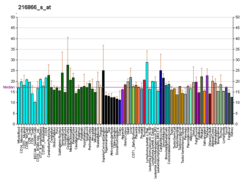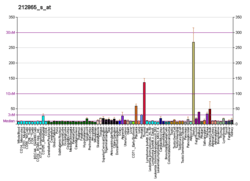Collagen, type XIV, alpha 1
Collagen alpha-1(XIV) chain is a protein that in humans is encoded by the COL14A1 gene.[5][6][7] It likely plays a role in collagen binding and cell-cell adhesion.[8]
References
- GRCh38: Ensembl release 89: ENSG00000187955 - Ensembl, May 2017
- GRCm38: Ensembl release 89: ENSMUSG00000022371 - Ensembl, May 2017
- "Human PubMed Reference:". National Center for Biotechnology Information, U.S. National Library of Medicine.
- "Mouse PubMed Reference:". National Center for Biotechnology Information, U.S. National Library of Medicine.
- Just M, Herbst H, Hummel M, Durkop H, Tripier D, Stein H, Schuppan D (Oct 1991). "Undulin is a novel member of the fibronectin-tenascin family of extracellular matrix glycoproteins". J Biol Chem. 266 (26): 17326–32. PMID 1716629.
- Bauer M, Dieterich W, Ehnis T, Schuppan D (Jan 1998). "Complete primary structure of human collagen type XIV (undulin)". Biochim Biophys Acta. 1354 (3): 183–8. doi:10.1016/S0167-4781(97)00131-0. PMID 9427527.
- "Entrez Gene: COL14A1 collagen, type XIV, alpha 1 (undulin)".
- https://www.uniprot.org/uniprot/Q05707
Further reading
- Schuppan D, Cantaluppi MC, Becker J, et al. (1990). "Undulin, an extracellular matrix glycoprotein associated with collagen fibrils". J. Biol. Chem. 265 (15): 8823–32. PMID 2187872.
- Schnittger S, Herbst H, Schuppan D, et al. (1995). "Localization of the undulin gene (UND) to human chromosome band 8q23". Cytogenet. Cell Genet. 68 (3–4): 233–4. doi:10.1159/000133920. PMID 7842743.
- Casini A, Ceni E, Salzano R, et al. (1994). "Regulation of undulin synthesis and gene expression in human fat-storing cells by acetaldehyde and transforming growth factor-beta 1: comparison with fibronectin". Biochem. Biophys. Res. Commun. 199 (2): 1019–26. doi:10.1006/bbrc.1994.1331. PMID 8135774.
- Tono-Oka S, Tanase S, Miike T, Tanaka H (1996). "Transient expression of collagen type XIV during muscle development and its reappearance after denervation and degeneration". J. Histochem. Cytochem. 44 (8): 907–18. doi:10.1177/44.8.8756762. PMID 8756762.
- Ehnis T, Dieterich W, Bauer M, et al. (1997). "A chondroitin/dermatan sulfate form of CD44 is a receptor for collagen XIV (undulin)". Exp. Cell Res. 229 (2): 388–97. doi:10.1006/excr.1996.0384. PMID 8986622.
- Göpel C, Schultka R, Schuppan D (1997). "[Age-dependent distribution of collagen and glycoproteins in the blood vessels of the human uterine tube]". Ann. Anat. 179 (1): 83–8. PMID 9092299.
- Ehnis T, Dieterich W, Bauer M, et al. (1997). "Localization of a binding site for the proteoglycan decorin on collagen XIV (undulin)". J. Biol. Chem. 272 (33): 20414–9. doi:10.1074/jbc.272.33.20414. PMID 9252349.
- Imhof M, Trueb B (1999). "Comparative cytogenetic mapping of COL14A1, the gene for human and mouse collagen XIV". Cytogenet. Cell Genet. 84 (3–4): 217–9. doi:10.1159/000015262. PMID 10393435.
- Fukushima M, Hirano S, Tanaka H (2000). "Dorsoventral differential distribution of collagen type XIV around the spinal cord is regulated by the ectoderm". Dev. Growth Differ. 41 (6): 751–8. doi:10.1046/j.1440-169x.1999.00472.x. PMID 10646805.
- Strausberg RL, Feingold EA, Grouse LH, et al. (2003). "Generation and initial analysis of more than 15,000 full-length human and mouse cDNA sequences". Proc. Natl. Acad. Sci. U.S.A. 99 (26): 16899–903. doi:10.1073/pnas.242603899. PMC 139241. PMID 12477932.
- Ota T, Suzuki Y, Nishikawa T, et al. (2004). "Complete sequencing and characterization of 21,243 full-length human cDNAs". Nat. Genet. 36 (1): 40–5. doi:10.1038/ng1285. PMID 14702039.
- Gerecke DR, Meng X, Liu B, Birk DE (2004). "Complete primary structure and genomic organization of the mouse Col14a1 gene". Matrix Biol. 22 (7): 595–601. doi:10.1016/j.matbio.2003.11.005. PMID 15065570.
- Brandenberger R, Wei H, Zhang S, et al. (2005). "Transcriptome characterization elucidates signaling networks that control human ES cell growth and differentiation". Nat. Biotechnol. 22 (6): 707–16. doi:10.1038/nbt971. PMID 15146197.
- Gerhard DS, Wagner L, Feingold EA, et al. (2004). "The status, quality, and expansion of the NIH full-length cDNA project: the Mammalian Gene Collection (MGC)". Genome Res. 14 (10B): 2121–7. doi:10.1101/gr.2596504. PMC 528928. PMID 15489334.
- Thierry L, Geiser AS, Hansen A, et al. (2005). "Collagen types XII and XIV are present in basement membrane zones during human embryonic development". J. Mol. Histol. 35 (8–9): 803–10. doi:10.1007/s10735-004-1132-y. PMID 15609093.
- Ruehl M, Erben U, Schuppan D, et al. (2006). "The elongated first fibronectin type III domain of collagen XIV is an inducer of quiescence and differentiation in fibroblasts and preadipocytes". J. Biol. Chem. 280 (46): 38537–43. doi:10.1074/jbc.M502210200. PMID 16129687.
- Rual JF, Venkatesan K, Hao T, et al. (2005). "Towards a proteome-scale map of the human protein-protein interaction network". Nature. 437 (7062): 1173–8. doi:10.1038/nature04209. PMID 16189514.
- Nusbaum C, Mikkelsen TS, Zody MC, et al. (2006). "DNA sequence and analysis of human chromosome 8". Nature. 439 (7074): 331–5. doi:10.1038/nature04406. PMID 16421571.
This article is issued from Wikipedia. The text is licensed under Creative Commons - Attribution - Sharealike. Additional terms may apply for the media files.






